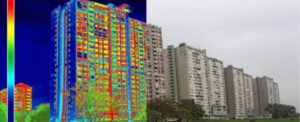In the design of new buildings, as well as in the renovation of existing ones, certain minimum requirements for energy performance must be respected, which have been established by Order of the Minister of Regional Development, Public Administration and European Funds, Deputy Prime Minister Sevil Shhaideh.
The modifications to the energy performance calculation methodology impose minimum energy performance requirements for the design of new residential buildings, non-residential buildings, and the renovation of existing buildings.
According to the new regulatory act, conducting an energy audit of a building involves four stages: a) Evaluating the energy performance of the building under normal conditions of use, based on the actual characteristics of the building system – related installations (heating, domestic hot water, ventilation, air conditioning, lighting); b) Compliance with the minimum energy performance requirements for buildings and their envelope elements, provided in Annex A15 “Minimum Energy Performance Requirements for Buildings and Their Envelope Elements” of Part I – Building Envelope, indicative Mc 001/1-2006; c) Identifying energy modernization measures and analyzing their economic efficiency; d) Preparing the energy audit report. The requirements for the design of new residential buildings are structured by construction elements and the overall building.
The standardized values are provided in the tables of the Minister’s Order.
In the energy design of residential buildings, the maximum specific annual consumption of primary energy from non-renewable sources for heating the building must also be respected.
It has been set at: * 153 kWh/m² per year for buildings with a height of less than Ground Floor + 4 floors, * 117 kWh/m² per year for buildings with a height of Ground Floor + 4 floors or higher.
Furthermore, the same Order stipulates minimum requirements for non-residential buildings, structured, on the one hand, based on the construction elements that are part of the building envelope, and, on the other hand, based on the overall building.
For example, the minimum requirements concerning the second category refer to the overall thermal insulation coefficient and the maximum specific annual consumption of primary energy from non-renewable sources for heating the building.
Once again, the standardized values are provided in the tables of the regulatory act.
The control coefficient values are listed by zones, based on the type of building: hospitals, nurseries, and clinics; educational and sports buildings; offices, commercial, and hotel buildings; other buildings (industrial buildings with normal operation regime).
The overall thermal insulation coefficient is a global thermal energy performance characteristic of buildings intended for purposes other than residential.
Furthermore, the Minister’s Order specifies the minimum requirements for hygrothermal comfort in new buildings. The minimum requirements for hygrothermal comfort for the construction elements that are part of the building envelope, as well as for new and existing buildings as a whole, are differentiated for various categories of buildings. For residential and non-residential buildings, the minimum requirements for the building’s construction elements, in terms of hygrothermal comfort, refer to temperature differences and thermal resistances.
In terms of hygrothermal comfort for the entire building, for residential and similar buildings, the minimum requirements refer to the minimum fresh air flow, while for non-residential buildings, the minimum requirements refer to air permeability and fresh air flow.
The regulatory act also mentions the minimum energy performance requirements for existing buildings. Last but not least, to determine the amount of primary energy required or consumed for heating a building, conversion factors from final energy (at the consumer level) to primary energy, corresponding to each type of fuel or energy source, are provided in the tables included in the Minister’s Order.
The information published on arenaconstruct.ro can be reproduced by other publications only within the limit of 500 characters and with the source cited, including an active link. Any deviation from this rule constitutes a violation of Law 8/1996 on copyright.
Find the normative act attached










